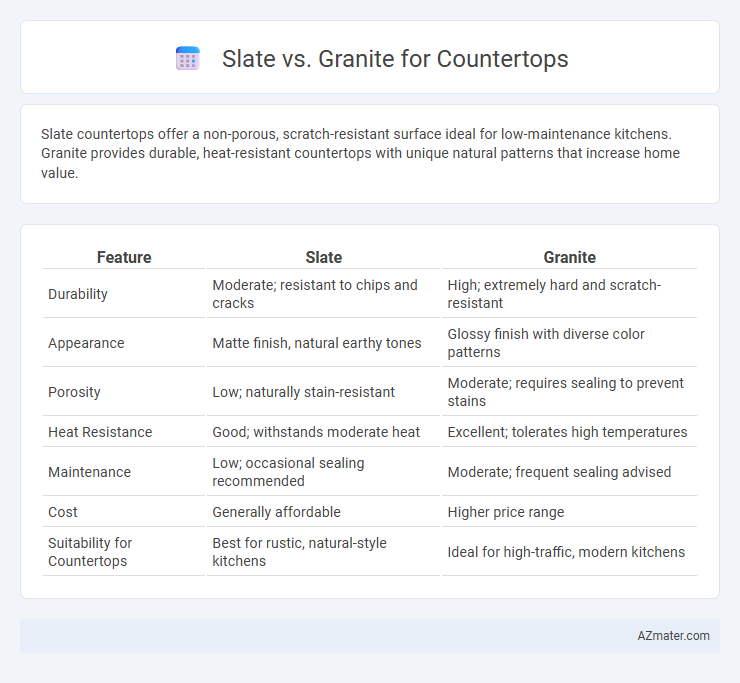Slate countertops offer a non-porous, scratch-resistant surface ideal for low-maintenance kitchens. Granite provides durable, heat-resistant countertops with unique natural patterns that increase home value.
Table of Comparison
| Feature | Slate | Granite |
|---|---|---|
| Durability | Moderate; resistant to chips and cracks | High; extremely hard and scratch-resistant |
| Appearance | Matte finish, natural earthy tones | Glossy finish with diverse color patterns |
| Porosity | Low; naturally stain-resistant | Moderate; requires sealing to prevent stains |
| Heat Resistance | Good; withstands moderate heat | Excellent; tolerates high temperatures |
| Maintenance | Low; occasional sealing recommended | Moderate; frequent sealing advised |
| Cost | Generally affordable | Higher price range |
| Suitability for Countertops | Best for rustic, natural-style kitchens | Ideal for high-traffic, modern kitchens |
Understanding Slate and Granite Countertops
Slate countertops offer a dense, fine-grained texture that is naturally resistant to heat, stains, and scratches, making them ideal for durable kitchen surfaces. Granite, an igneous rock composed mainly of quartz and feldspar, provides a highly durable and visually appealing option with its unique crystalline patterns and a wide range of colors. Both materials require proper sealing to maintain their resistance to moisture and staining, ensuring long-lasting performance in countertop applications.
Key Differences Between Slate and Granite
Slate countertops offer a uniform, smooth texture with a matte finish, making them resistant to scratches and heat but more prone to chipping compared to granite. Granite features a natural, polished surface with unique veining patterns, providing superior durability and resistance to staining through its dense composition. Both materials require sealing, but granite generally offers better long-term maintenance and a wider range of color options for kitchen countertops.
Appearance and Color Variations
Slate countertops feature a smooth, matte finish with subtle, natural veining that gives a sophisticated, understated look, often available in shades of gray, blue-gray, and black. Granite offers a more polished surface with a wide spectrum of color variations such as white, pink, black, green, and beige, characterized by bold patterns and speckles formed by mineral deposits. The distinct visual texture of granite makes it ideal for vibrant, eye-catching kitchen designs, while slate suits minimalist or rustic aesthetics with its uniform, muted tones.
Durability and Longevity Comparison
Slate countertops offer exceptional resistance to heat, scratches, and stains due to their dense, fine-grained structure, making them highly durable for kitchen use. Granite, composed of interlocking mineral crystals, provides superior hardness and long-lasting strength, often withstanding heavy impacts and daily wear more effectively. Both materials boast impressive longevity, but granite typically edges out slate in overall durability and maintenance ease, ensuring countertops can endure decades of use.
Maintenance and Cleaning Requirements
Slate countertops require minimal maintenance due to their natural resistance to stains and scratches, needing only occasional sealing to maintain durability. Granite countertops benefit from periodic sealing to prevent staining and preserve their polished surface, with daily cleaning involving mild soap and water to avoid damage. Both materials demand prompt cleanup of spills, but slate's matte finish generally conceals smudges and fingerprints better than granite.
Cost Analysis: Slate vs Granite
Slate countertops typically cost between $50 and $70 per square foot, making them a more affordable option compared to granite, which ranges from $60 to $100 per square foot depending on the quality and origin. Installation expenses for both materials are relatively similar, but granite's higher price often reflects its durability and aesthetic appeal, which may justify the investment for long-term value. Budget-conscious homeowners may prefer slate for its cost-efficiency, while those seeking premium look and durability might lean toward granite despite the higher upfront cost.
Installation Process and Considerations
Slate countertops offer a lighter weight and easier installation process compared to granite, making them suitable for DIY projects and reducing labor costs. Granite requires professional installation due to its heavier weight and need for precise cutting and sealing to prevent cracks and stains. Both materials demand a sturdy, level base, but granite's hardness necessitates specialized tools and expertise, impacting overall project time and budget.
Pros and Cons of Slate Countertops
Slate countertops offer exceptional durability and resistance to stains, heat, and scratches, making them a practical choice for high-traffic kitchens. Their natural slip resistance and unique earthy appearance provide an elegant, rustic aesthetic that blends well with various design styles. However, slate can be more prone to chipping along edges and requires periodic sealing to maintain its stain resistance and prevent moisture absorption.
Pros and Cons of Granite Countertops
Granite countertops offer exceptional durability, heat resistance, and natural beauty with unique patterns that enhance kitchen aesthetics. However, they require regular sealing to prevent stains and are prone to chipping or cracking if heavy objects are dropped. Compared to slate, granite is generally more expensive and heavier, demanding professional installation to ensure stability and longevity.
Which Countertop is Best for Your Needs?
Slate countertops offer a durable, non-porous surface resistant to stains and scratches, making them ideal for low-maintenance kitchens that require toughness and longevity. Granite provides a highly durable, heat-resistant option with unique natural patterns and colors, suited for homeowners prioritizing aesthetics and premium durability. Choosing between slate and granite depends on whether you value ease of care and understated elegance or striking appearance and high-end durability for your countertop needs.

Infographic: Slate vs Granite for Countertop
 azmater.com
azmater.com